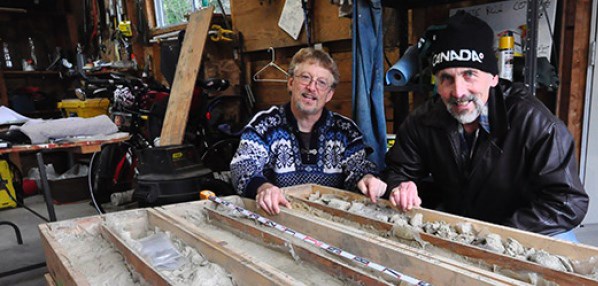A pair of SFU scientists got an early Christmas present when a pallet laden with boxes of ancient dirt were dropped off at a Coquitlam garage.
The boxes contain nearly 600 feet of drill core samples that were pulled up during Evergreen Extension construction, giving Lionel Jackson and Brent Ward a once-in-a-lifetime opportunity to study the geological history of a bustling urban centre.
"The cores give us a very detailed summary of what's happened here," said Jackson, an adjunct professor and an emeritus at the Geological Survey of Canada, as he examined the cores in his garage. "It tells a story."
After a particularly soggy couple of months it may come as no surprise that much of the Tri-Cities was well below sea level about 16,000 years ago; a retreating glacier left a deep depression that turned the area between Burnaby Mountain and Coquitlam's Town Centre into ocean, and the two regions into islands.
Another box contains a section of pale grey volcanic ash — a sign that a massive volcano erupted nearby about 26,000 years ago — that would have blanketed the Lower Mainland.
"If this happened now it would be a really big deal," said Ward, much like how Wenatchee was hit hard with ash from the Mount St. Helens eruption in 1980.
The material was offered to the scientists by a former student of Ward's who was working on the Evergreen project with contractor SNC-Lavalin.
"We went down there immediately," Jackson said, with both scientists eager to get their hands on the material. "I couldn't bear the idea of this going to the dump so I said, 'Bring it to my house.'"
A crane truck brought the pallet over in late September and Ward and Jackson have been combing through it, cataloguing the material, describing it and sending pieces of it to a lab for further analysis. They've spotted plant material in a section of dark, clumpy dirt between layers of sediment, an indication the area would have likely been a small pond at one time, and hope to discover insect remains within the samples.
"When I got the records what really impressed me is that none of the wells, except for the deepest ones, had hit bedrock," Jackson said. Most of the samples contain sand, sediment, volcanic ash and glacial till.
Some of the cores that have yet to be studied extend to below sea level, giving Ward and Jackson an otherwise impossible opportunity since drilling the cores themselves would likely have cost them millions of dollars and plenty of neighbourhood opposition.
Jackson said the drill cores were not only a tremendous research opportunity but also an important tool in an ever densifying region.
"Urban geology is becoming more and more significant," he said, given the number of high-rise towners and transportation tunnels being built. "To understand what cities are built on is very important."



